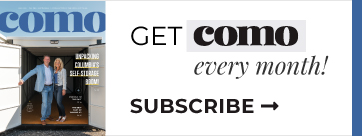Buildings, Business and Battle Lines
There’s nothing of any architectural significance about 225 S. Ninth St.: a squat, single-story, 1920s-era structure its owner wants to tear down and replace. There’s absolutely nothing about this pile of bricks that can compare with contemporaneous Columbia architectural achievements that include the Missouri Methodist Church, Central Dairy Building, Tiger Hotel, Missouri Theatre and Missouri State Teachers’ Association headquarters, to name a few. Tenanted in the past by the Dinkle Barber Shop, Al’s Shoe Hospital, Vet’s Appliance Service, Dawson Shoe Repair, the Drop-In Sandwich Shop, Eddie’s Toggery, the Food Center grocery, Topsy’s Ice Cream and Max’s Campus Snack, among others, these bricks for more than 40 years have encapsulated the original Shakespeare’s location, a local legend among pizzerias. Now, the northwest corner of Ninth and Elm has joined a crosstown relative at the southeast corner of Providence and Broadway ensnarled in an extended-play twin bill of municipal obfuscation and delay in the court of the Columbia City Council and several advisory commissions.
Any expectation that CVS will be allowed to build where the Boone County Mill once stood is fading, as perhaps it should. If I were in their wheelhouse, I’d say forget about this spot because the southeast corner of Providence and Broadway is jinxed, and the Creator laid the hex upon it eons ago. Flat Branch, after all, is a creek, represented by a blue line on the U.S. Geological Survey’s 1:24,000 scale “Columbia” Quadrangle map, and it runs beneath the property CVS has been coveting for its debut operation here. What has become ludicrous is the tug-of-war about appearance and design pitting CVS and its local counsel against the seemingly unflappable City Council and its surrogates: the seven-member Historic Preservation Commission of the architectural cognoscente and an even larger contingent of Downtown Leadership Council members. One story or two? Or how about 26 stories with views from the top to boot and maybe a revolving restaurant on the roof?
After the mill was torn down following MFA’s July 1967 move from 32 S. Providence Road to 2420 Paris Road, the southeast corner was up for grabs at a time before the EPA, DNR and other regulatory agencies could impose their binding environmental ukases. The intersection was at the time a hodgepodge of mixed commercial structures and uses including several gas stations, the Oriental Bazaar, Midwest Auto topped by a super-sized figure of Paul Bunyan and Uncle Clem’s Corner, which was memorialized by a string of corny commercials that punctuated the airwaves of KFRU. Since the northeast corner has been cleared and turned into a parking lot, the highest and best use of the controversial southeast corner is undoubtedly some parkland, sure to make City Hall’s micromanagers grin like a gaggle of Cheshire cats.
Change was in the air on Feb. 28, 1968, when the Katz Drug Co. of Kansas City and the late Edgar Wayland announced plans to build a 46,000-square-foot “super” drug store on several dozen acres Wayland owned at the southwest corner close to the busy intersection. Previously known as Cemetery Hill, this was one of several notorious sites dotted with slum shacks and “frost-proof” toilets occupied by Columbia’s segregated black community that had been swept clean by the Land Clearance for Redevelopment Authority as part of the city’s ambitious 100-acre urban renewal project that began in 1956. The Katz Discount Drug Store opened in the fall of 1968, but the chain was sold to Skaggs in 1971, which became OSCO, acquired ironically by CVS in January 2006.
At this point, the rather ordinary building at 225 S. Ninth might be with us for a while or maybe in perpetuity just like the rambling old building at 920 Cherry St. that was saved from destruction a while back. The recent election ensured this, and maybe that’s for the better if that’s how the community at large feels about historic preservation. The electorate of Columbia and its representatives remain sharply divided. “Focusing on the fundamentals” is one of those vacuous slogans that won’t be fulfilled by any move to the center or interest in compromise. Representatives operate along digital lines because they are unabashedly beholden to those who support them under threat of recall, as recent history has shown. The lines of battle in this community are very clear: liberal vs. conservative, town vs. gown, “smart” growth vs. stupid growth, progressive vs. Neanderthal. You don’t need a weatherman to figure out how our solons will vote. It would probably be a good time to change the City Charter and stick party labels on those who represent us. It’s OK if you’re a democrat or a republican. At least with a party label, we’ll have a pretty good idea of how you feel about something, and there’s nothing wrong with that.


